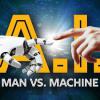
Breaking News
 The Days of Democracy Are Over
The Days of Democracy Are Over
 Elon Musk Described an AI Device to Replace Phones in 5 Years
Elon Musk Described an AI Device to Replace Phones in 5 Years
 Deposit Insurance For Billionaires?
Deposit Insurance For Billionaires?
 Rep. Troy Balderson Is Right: Coal And Gas Drive Affordable, Reliable, And Clean Energy
Rep. Troy Balderson Is Right: Coal And Gas Drive Affordable, Reliable, And Clean Energy
Top Tech News
 Graphene Dream Becomes a Reality as Miracle Material Enters Production for Better Chips, Batteries
Graphene Dream Becomes a Reality as Miracle Material Enters Production for Better Chips, Batteries
 Virtual Fencing May Allow Thousands More Cattle to Be Ranched on Land Rather Than in Barns
Virtual Fencing May Allow Thousands More Cattle to Be Ranched on Land Rather Than in Barns
 Prominent Personalities Sign Letter Seeking Ban On 'Development Of Superintelligence'
Prominent Personalities Sign Letter Seeking Ban On 'Development Of Superintelligence'
 Why 'Mirror Life' Is Causing Some Genetic Scientists To Freak Out
Why 'Mirror Life' Is Causing Some Genetic Scientists To Freak Out
 Retina e-paper promises screens 'visually indistinguishable from reality'
Retina e-paper promises screens 'visually indistinguishable from reality'
 Scientists baffled as interstellar visitor appears to reverse thrust before vanishing behind the sun
Scientists baffled as interstellar visitor appears to reverse thrust before vanishing behind the sun
 Future of Satellite of Direct to Cellphone
Future of Satellite of Direct to Cellphone
 Amazon goes nuclear with new modular reactor plant
Amazon goes nuclear with new modular reactor plant
 China Is Making 800-Mile EV Batteries. Here's Why America Can't Have Them
China Is Making 800-Mile EV Batteries. Here's Why America Can't Have Them
Switchable window material stays clear while blocking the sun's heat

A new switchable window material, however, blocks incoming heat while remaining mostly transparent.
First of all, there are already windows with electrochromic glass, that electronically tints on demand. As the glass gets darker, though, it gets harder to see through. Additionally, although such windows do partially block the visible spectrum of sunlight, they don't necessarily block the infrared spectrum, which produces the heat.
That's where the new material comes in.
Developed by scientists at Singapore's Nanyang Technological University and Israel's Hebrew University of Jerusalem, it consists of an inexpensive mixture of titanium dioxide, tungsten trioxide, neodymium-Niobium and tin oxide. This is applied as a coating to ordinary window pane glass, and connected to an electrical circuit.
When the extra heat provided by the sunlight is wanted, such as during the winter months, the material is left switched off. This allows all of the sunlight's infrared radiation to pass through. During warmer months, however, the power is switched on – simulations have indicated that the material will then block up to 70 percent of the incoming infrared radiation, while still allowing up to 90 percent of the sun's visible light to pass through.
Additionally, whereas existing electrochromic windows reportedly start losing their functionality after three to five years of use, tests involving repeated on/off cycles have shown that the new material should last much longer.
What's more, windows incorporating the technology could also be coated with an electronically switchable film created by the same team, which uses carbon nanoparticles to either conduct or block the passage of ambient heat from the outdoor environment.

 China Innovates: Transforming Sand into Paper
China Innovates: Transforming Sand into Paper

